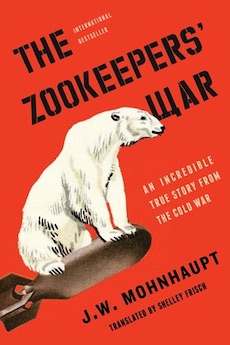By Carol A. Leibiger
The post-World War II division of Berlin brought about the doubling of cultural, social, and political institutions, which existed in competition during the Cold War. In The Zookeepers’ War (German title: Der Zoo der Anderen) German journalist and essayist Jan Mohnhaupt provides a fascinating story of a microcosm of this phenomenon in his history of East and West German zoos. He focuses on the premier German zoos, West Berlin’s Zoologischer Garten and East Berlin’s Tierpark. While the zoos offered animal-loving Germans “havens…of an unspoiled world,” each justified the other’s existence, acquisitions, and growth as symbols of their particular cities, countries, and political systems. The central characters are the West and East Berlin zoo directors, Heinz-Georg Klös and Heinrich Dathe, respectively, “Cold Warriors whose zoos were…arenas” in which their personal and professional rivalry played out. These directors assumed their positions following World War II, rose to prominence by exploiting their political contexts, and saw their influence and importance fade after the Reunification. The zoos’ rivalry lives on, despite their merger into Zoo, Inc., with east-west tensions continuing to be reflected in citizens’ preference for one zoo over another, as East and West Berliners identify with the Tierpark or Zoologischer Garten, respectively.
Mohnhaupt enriches his narrative with stories of other German zoos, zookeepers, and developments in zookeeping during and after the Cold War. Because secondary zoos such as those in (West German) Frankfurt and (East German) Leipzig were not located in politically significant West Berlin or the GDR’s capital, they suffered the economic and political challenges typical of the times. Additional stories relate amusing or thrilling escapes by East German zoo personnel, who exploited close relationships between East and West German zoos, e.g., zookeeper Gerd Morgen’s 1961 escape in a crate containing a moose en route to the Zoologischer Garten. Other stories recount daring or shady dealings involving animal trappers and dealers, who provided the exotic and endangered species that attracted visitors and enhanced a zoo’s (and a zoo director’s) image. Mohnhaupt chronicles improvements in zoos, such as housing animals in areas resembling their natural habitats, exchanging animals between zoos rather than obtaining them from trappers or through “panda diplomacy,” and breeding and releasing endangered species into reserves. These developments reflect current collaboration between zoos, which are no longer their directors’ fiefdoms.
Richly researched and engagingly written, this book will captivate general readers. Mohnhaupt has chosen not to include footnotes in order to “preserve the narrative form and flow of the book.” This lack can stymie readers wishing to find the sources of specific textual information in the extensive bibliography of academic, popular, and personal resources. Since the narrative is not presented in linear fashion, Mohnhaupt’s lack of consistency in providing dates for events might confuse Anglophone readers not familiar with recent German history. These weaknesses aside, readers will enjoy this fascinating glimpse into a microcosm of German culture and politics that played out on the larger stages of the Cold War and the Reunification.
Reviewer Carol A. Leibiger (ΦΒΚ, University of Connecticut) is an associate professor in the I.D. Weeks Library at the University of South Dakota.




